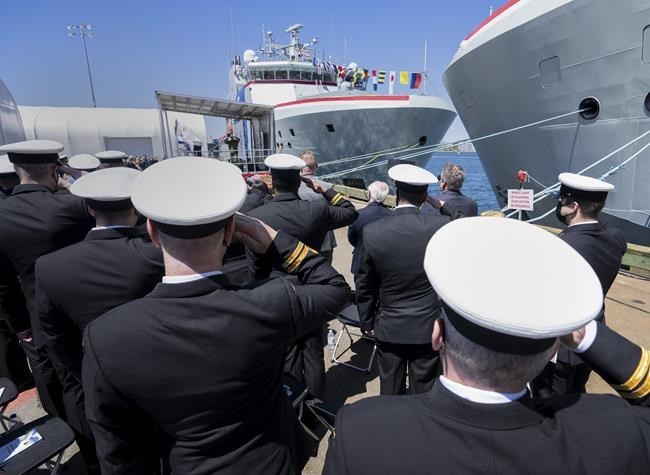OTTAWA — The Royal Canadian Navy will need to wait an extra two years for the delivery of new support ships, the federal government said Thursday, meaning Canada will need to rely on a civilian ship and the goodwill of allies to resupply its naval fleet for the foreseeable future.
The first of two new support ships being built by Seaspan Shipyards in Vancouver will not be delivered until at least 2025 — two years later than the most recent estimate.
The new delivery schedule, if it sticks, is now six years later than originally anticipated.
By that time, the navy will have been without a permanent supply ship for a full decade.
The second vessel will face a similar delay, and now is not expected until 2027.
Navy officials have previously stressed the importance of having purpose-built support ships for overseas operations given the limitations of relying on allies and the civilian vessel's inability to operate in war zones.
Even then, the new schedule is no certainty. Delays and cost overruns have plagued much of Canada’s decade-long, multibillion-dollar effort to replace its aging navy and coast guard fleets.
In providing the update on Thursday, officials also could not guarantee Canada will end up with both support ships.
They say the project’s budget, originally set at $2.3 billion but later updated to $4.1 billion, is now under review.
Seaspan has already started work on the second joint support ship, as the vessels are known in military circles, and Defence Department procurement chief Troy Crosby said the government’s stated goal remains the purchase of two such ships.
However, Crosby added, “it's something that we're assessing now and will provide an update once we have a better understanding of exactly the cost impact.”
It also wasn’t immediately clear what effect the new delay will have on the other shipbuilding projects that Seaspan is working on, which includes a new polar icebreaker to replace the coast guard’s flagship by 2030.
Canada has been without a permanent supply ship since 2015, when the navy was forced to retire its existing two vessels earlier than expected after one caught on fire while at sea and excessive corrosion was discovered on the other.
The government initially relied on allies to fill the gap before agreeing to lease a converted civilian container ship from Quebec-based Chantier Davie. That deal was at the heart of the failed prosecution of retired vice-admiral Mark Norman.
The military’s former second-in-command was accused of leaking cabinet secrets about the leasing agreement with Davie, but the breach-of-trust charge against him was stayed in 2019 when Crown prosecutors concluded that they had no reasonable chance of securing a conviction. Earlier this month, the Crown also dropped its related case against a federal public servant. Both men had maintained their innocence.
While the initial five-year lease agreement between Ottawa and Davie for the MV Asterix was launched in January 2018 and due to expire next year, officials said the government is now negotiating an extension.
Documents obtained by The Canadian Press in 2020 showed the navy expects to continue relying on the Asterix and allies to help resupply Canada’s fleets at sea even after the two joint support ships are built.
Canada originally planned to buy three new navy support ships when it launched the project more than a decade ago, but cost overruns saw the order cut down to two.
Navy officials continued to indicate that two support ships were not enough to meet the maritime force’s long-term needs, as the government’s policy requires the military be able to operate two fleets at sea at the same time.
The fear is that the navy will be hamstrung whenever one of the two so-called joint support ships is out of commission, either for repairs or for some other reason.
Asked whether the government was looking to purchase the Asterix outright from Davie, as some observers have previously suggested, the senior official responsible for military procurement at Public Service and Procurement Canada said no.
“Discussions and negotiations at the moment are just truly and only about extending the contract as we know it now,” said Simon Page, the department's assistant deputy minister.
Royal Canadian Navy commander Vice-Admiral Angus Topshee said the force will continue to rely on the Asterix and allies for assistance resupplying at sea, but he acknowledged both stopgaps have drawbacks and limitations.
Those include the fact the Asterix is not designed for “high-threat environments,” Topshee said. It also means the navy cannot currently meet the government’s requirement that it be able to operate two fleets at sea at the same time.
“Can we manage? Yes,” Topshee said.
“Is it ideal? No, that's why we're building the two joint support ships.”
The new delay is the latest blow to the federal government’s effort to replace the aging fleets of both the navy and Canadian Coast Guard — an effort that has already dragged on for more than a decade and is now projected to cost around $100 billion.
While officials blamed a combination of factors, including the COVID-19 pandemic and supply-chain problems, many of the issues predate both and have been pinned on both the government and shipyards.
This report by The Canadian Press was first published June 30, 2022.
Lee Berthiaume, The Canadian Press


